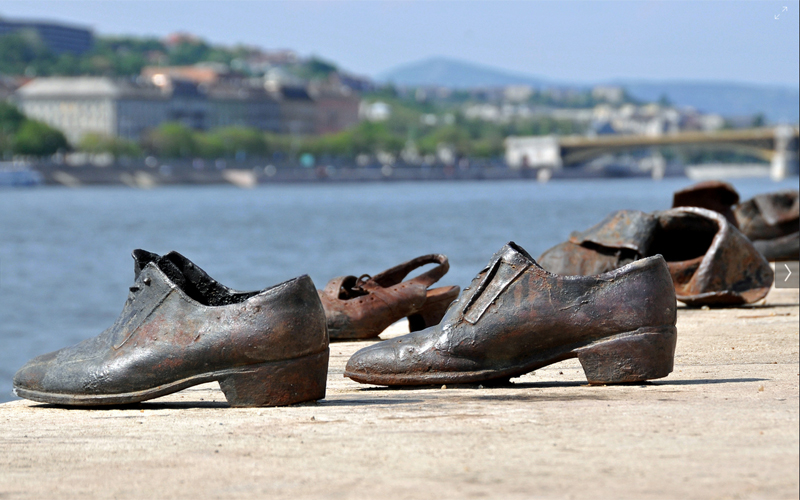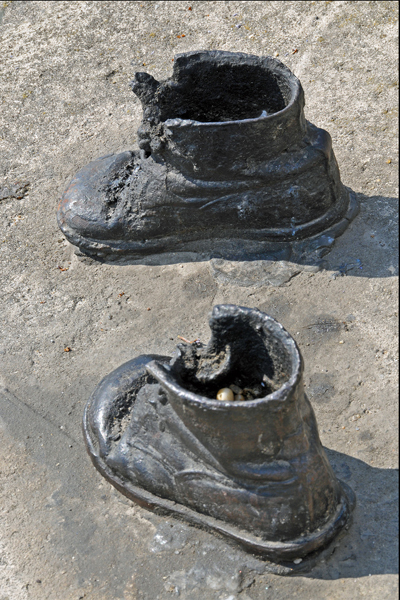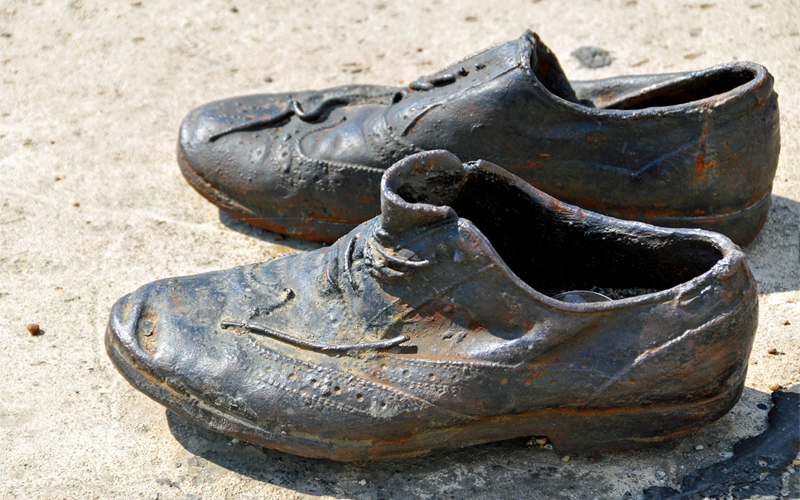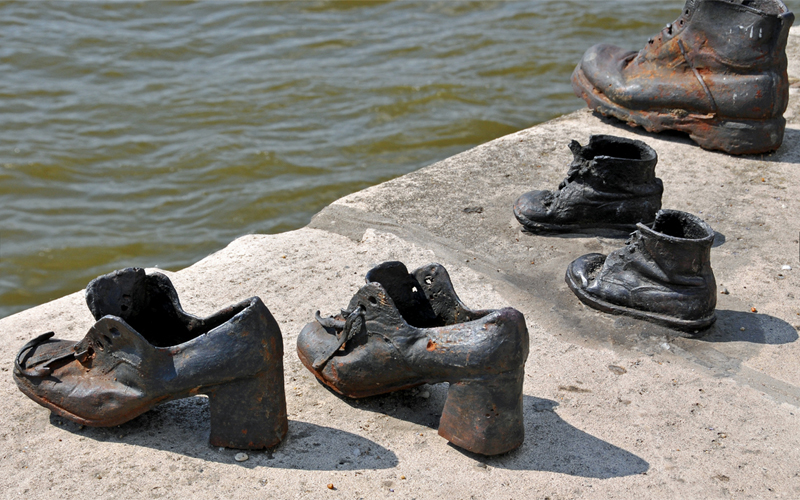- T. Zane Reeves, Ph.D., Shoes Along the Danube: Based on a True Story (Durham: Strategic Book Group, 2011), p. 190.
- Ibid.
- Ibid.
- Zsuzsanna Ozsváth, "From Country to Country: My Search for Home" in Alvin Rosenfeld, ed., The Writer Uprooted: Contemporary Jewish Exile Literature (Bloomington: Indiana University Press, 2008), p. 185-186.
On the banks of the Danube River in Budapest, not far from the Hungarian Parliament building, sit sixty pairs of old-fashioned shoes, the type people wore in the 1940s. There are women's shoes, there are men's shoes and there are children's shoes. They sit at the edge of the water, scattered and abandoned, as though their owners had just stepped out of them and left them there.
If you look more closely, you see that the shoes are rusted, made of iron and set into the concrete of the embankment. They are a memorial and a monument to the Hungarian Jews who, in the winter of 1944-1945, were shot on the banks of the Danube River by the members of the Arrow Cross Party. Known as "The Shoes on the Danube Promenade", the memorial was conceptualized by film director Can Togay, and was created by Togay together with the sculptor Gyula Pauer. It was installed on the Pest bank of the Danube River in Budapest in 2005. At three separate places on the memorial, cast iron signs read in Hungarian, English and Hebrew: "To the memory of victims shot into the Danube by Arrow Cross militiamen in 1944-45."
During that autumn and winter, after the Germans had toppled the government of Miklos Horthy bringing Ferenc Szálasi and his fascist, violently antisemitic Arrow Cross Party to power, the Arrow Cross introduced a reign of terror in Budapest. The Arrow Cross militiamen ran amok in the streets of Budapest, beating, plundering, and killing Jews publicly. Thousands of Jews were murdered all over the city. Shooting the Jews into the Danube was convenient because the river carried the bodies away. Often, the Arrow Cross murderers would force their terrified Jewish victims to remove their shoes before shooting them into the Danube. Shoes, after all, were a valuable commodity during World War II. The killers could use them, or trade them on the black market. This, then, is the historical reality behind the monument. Sometimes, though, the victims' shoes were so worn-out and useless, that the militiamen killed the Jews with their shoes still on. And sometimes, the Arrow Cross pulled the shoestrings out of children's shoes, and used them to tie the helpless Jewish victims' hands together before they were shot. Sometimes they used rope instead. The killers faced their victims without mercy; the victims faced the killers without blindfolds. In some cases the Arrow Cross men tied together the hands of two or three Jews – adults or children. Then they would shoot only one of the people who were tied together. When they did their work properly and positioned their victims at the edge of the water, all three would fall into the Danube, the dead body pulling the still-living victims with it.1 All the bodies, tied together by shoelaces or rope or fate, would either sink or float away down the river. If the militiamen noticed that Jews were still alive, they used them for target practice. However, most of the Jews – especially the children – died immediately because the water was freezing cold.2 During the days of horror in the winter of 1944-1945, the Danube was known as "the Jewish Cemetery."3
A firsthand account of the horrific scenes along the Danube was presented by Zsuzsanna Ozsváth, a Hungarian survivor who was saved by her nursemaid, Erzsi Fajo.
“…I heard a series of popping sounds. Thinking the Russians had arrived, I slunk to the window. But what I saw was worse than anything I had ever seen before, worse than the most frightening accounts I had ever witnessed. Two Arrow Cross men were standing on the embankment of the river, aiming at and shooting a group of men, women and children into the Danube – one after the other, on their coats the Yellow Star. I looked at the Danube. It was neither blue nor gray but red. With a throbbing heart, I ran back to the room in the middle of the apartment and sat on the floor, gasping for air." 4
How is it possible to commemorate the victims of such incredible brutality in a way that is fitting? Togay and Pauer came up with the idea of using the shoes left behind by some of the victims on the riverbank. Their memorial remains true to the 70-year old history, while connecting it with the more immediate, and shocking, sensation of seeing the abandoned shoes today along the bank of the Danube as if their owners had, just now, left them there.
The memorial is so effective because the touchable, corporeal shoes along the river, left behind empty and without their owners, force us to confront the question: whose shoes were they? Who were the people that are missing from the sculpture? Further, each of the shoes is different. Some have worn-down heels, others have shabby uppers; some have laces, others have straps left open; some are classic women's pumps, others are workmen's boots; some are standing straight up, while others have fallen over, as though they were hastily taken off. And then there are the tiny shoes of the children. All these different shoes represent the different individual Jews who were murdered on the riverbanks.
- 4. 4
The intimacy of this memorial is striking and poignant. The shoes are so tangible that it is easy to imagine the people who wore them, whose feet shaped them, who were forced to take them off before they were killed. Each shoe has a personality; each has the imprint of the foot that wore it. The only thing missing is the owner. The shoes help us to conjure up something akin to the faces of the owners – those whose faces were obliterated – turning them from statistics into living, breathing human beings. They remind us that these were people. They may have lived long lives, fulfilling lives, lives filled with adventure or with boredom, rich lives or ordinary lives, but they lived, until they were murdered.
In an installation like this, each individual shoe is a work of art in itself. The sculptor must have held it in his hand; he must have thought about the person who had worn, and worn down, the shoe; he must have shaped the iron and manipulated the material to reflect the human being who would have chosen that particular style. Was she a woman of means? Was he a construction worker? Then, after envisioning the person who would have bought the shoe, the sculptor must have thought about how that person wore it down. Did he walk enthusiastically on his toes or stride with his feet turned out? Did she force her feet impatiently into the shoes without undoing the straps or did she slip her pumps on over her silk stockings? Each shoe was considered, each individual was envisioned. This reinforces the individuality of the owners that makes the monument so intimate and striking. Looking at the shoes triggers an initial sense of shock at their emptiness and the vacuum left behind, and then a profound sadness at the fate of the people who were forced to take them off, standing at the edge of an icy river, terrified and facing men with guns.
People who visit the memorial sometimes light candles or leave behind flowers, placing them inside a particular shoe that touches them or reminds them of someone. This is what makes the monument transcend the actual events in Hungary 70 years ago: we can look at the shoes left behind and put ourselves in the shoes of those who were killed – literally and figuratively. Shoes are universal. They are a basic commodity that we all own. Despite the individuality of each of the shoes and the particularity of the events that transpired on the freezing banks of the Danube in that dark winter of 1944-1945, the monument challenges us to look at the bigger picture, and think about the mass murder of individuals, wherever it occurs.










